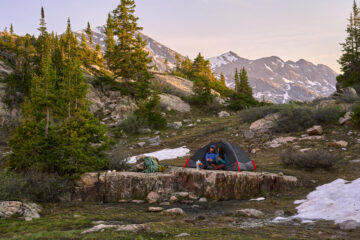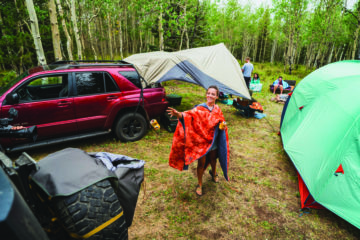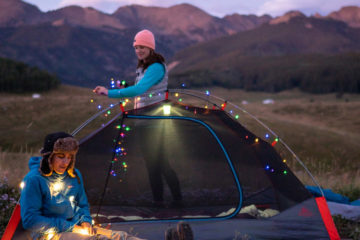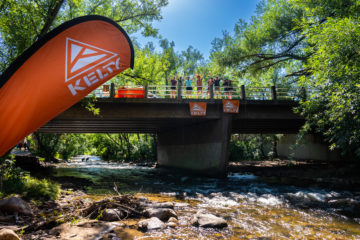Hopefully you’ve been following our “How To Choose” gear guides, so this will be the next step in the process of gearing up like a pro but not hitting the wallet hard. If you’re a true nature newbie, you may not know that when it comes to staying warm while camping, a well-chosen sleeping bag is only half the equation! Yes, a toasty bag will go a long way towards a good night’s sleep. But if you want the Great Outdoors to still feel great the next morning, you’ll need to add the right sleeping pad to the mix.
Why? Ideally, your backpacking sleeping pad and sleeping bag should work together—the bag’s insulation and other heat-retaining features help to absorb and trap your body heat, while the sleeping pad provides a helpful barrier between your trail-weary body and the cold, hard ground. Here’s how to choose a backpacking sleeping pad for your next backcountry escape.

How to Choose a Sleeping Pad
CONSTRUCTION. There are three basic types of camping sleeping pads: closed-cell foam, air pads and self-inflating air pads. Closed-cell foam sleeping pads, while typically lightweight and less expensive, tend to be bulky to carry and are generally stiffer and less comfortable.
Kelty prefers (and makes) air sleeping pads, which pack down smaller and offer more cushioning and insulation than foam. Of these, regular air sleeping pads are inflated either by you, a manual pump or an electric pump. There’s a huge range in this category, from the lightest and most compact backpacking sleeping pad to full-on air BEDS for you glampers.
A few things to note about regular air sleeping pads—if you’re sharing your tent with a dog, these can be prone to tearing, to be sure you have a patch kit handy. You may also find that firmness fluctuates with the temperature, so be sure to check this before you turn in. And finally, if you’re using lung power to inflate, you may get some condensation inside; for longer product life, always store with the inflation valve open to encourage air flow.
Self-inflating sleeping pads, as the name suggests, don’t need your hot air or anything else! These are constructed with a combination of open-cell foam and air, so they are a bit heavier and bulkier than regular air pads. But what you sacrifice in pack weight, you’ll gain in insulation and durability—and of course, you won’t have to waste an ounce of breath to blow them up.
SHAPE. Speaking very generally, camping sleeping pads come in shapes that align with the shapes of sleeping bags—rectangular, semi-rectangular and mummy. And, as with the shape of your sleeping bag, it’s the usage that’s driving this shape.
Rectangular sleeping pads, especially double-wides, are great for car camping and festivals; if you’ve got room in the car and/or the tent, bigger is usually better. With semi-rectangular and mummy backpacking sleeping pads, your biggest consideration will usually be weight. every square inch of pad you’re not actively resting on is likely contributing extra ounces to your pack—you don’t need to be super rigid about this rule, but ideally, you want your sleeping pad to be very similar in both size and shape to your backpacking sleeping bag.
R-VALUE. This technical-sounding term is actually pretty simple to understand and use—it’s a universal rating system that indicates your sleeping pad’s ability to resist heat flow. The higher the R-value, the better it will protect you from the cold ground.
R-values generally range from less than 2 to 5.5. If it’s really cold, and you don’t mind schlepping an extra sleeping pad along, you can layer your lower-R-value pads; two pads rated at 2.5 will add up to a 5.0 And remember, your sleeping bag and sleeping pad are a team! If you use a low R-value sleeping pad, your sleeping bag might not live up to its temperature rating. So…who should use what? We’ve got that covered, below.
FIRST-TIMERS: MISTRAL SI. Weighing in at under three pounds, including its stuff sack—and costing under 40 bucks, too—this self-inflating pad pairs perfectly with its companion Mistral sleeping bag, which is also priced just right. More comfy for less money? Hells to the yes.
CAR-CAMPERS: GALACTIC AIR or WAYPOINT. With a deluxe stretch fabric topper and a luxurious 3.5-inch thickness, Galactic is a non-insulated pad that suspends your weary, hiked-all-day bones in cushy softness. Waypoint also features super-soft stretch fabric, and even ups the ante by self-inflating; for extra firmness, use the stuff sack for manual inflation!
FAIR-WEATHER FRIENDS: COSMIC AIR. Like Snoop Dogg, this compact and lightweight air sleeping pad is ready to rock after just a few puffs! Pair this non-insulated mummy pad with its sibling, the Cosmic sleeping bag, for warm-weather backcountry adventures.
GLAMPING GODDESS: KUSH. Maybe your post-hiking hips have seen better days…or maybe something other than sleep is in the stars! Regardless, this queen-sized superstar has got your back—and every other part of you, too. Pair it with the Kush bag or Tru.Comfort Doublewide.
Stay tuned for more beginning backpacker tips, with great gear to get you out there in style—and be sure to follow @keltyusa for all kinds of cool camp content. See you out there!











